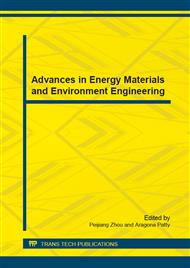[1]
D. Salomonsson, Modeling, control and protection of low-voltage DC microgrids, (2008).
Google Scholar
[2]
P. Heer, Decentralized model predictive control for smart grid applications, (2013).
Google Scholar
[3]
J. Maciejowski, Predictive control with constraints, U. o. C. Department of Engineering, Ed., Prentice Hal, (2001).
Google Scholar
[4]
B. Picasso, D. D. Vito, R. Scattolini and P. Colaneri, An MPC approach to the design of two-layer hierarchical control systems, Automatica, vol. 46, pp.823-831, (2010).
DOI: 10.1016/j.automatica.2010.02.013
Google Scholar
[5]
K. Trangbaek, M. Pedersen, J. Bendtsen and J. Stoustrup, Predictive smart grid control with exact aggregated power constraints, Springer, 2012, pp.649-668.
DOI: 10.1007/978-3-642-21578-0_21
Google Scholar
[6]
S. Rehman, Empirical model development and comparison with existing correlations, Applied Energy, vol. 64, pp.369-378, (1999).
DOI: 10.1016/s0306-2619(99)00108-7
Google Scholar
[7]
M. Paulescua, L. Farab and E. Tulcan-Paulescu, Models for obtaining daily global solar irradiation from air temperature data, Atmosphere Research, vol. 79, pp.277-240, (2006).
DOI: 10.1016/j.atmosres.2005.06.001
Google Scholar
[8]
A. Mellita, S. Kalogiroub, S. Shaaric, H. Salhid and A. H. Arab, Methodology for predicting sequences of mean monthly clearness index and daily solar radiation data in remote areas: Application for sizing a stand-alone PV system, Renewable Energy, vol. 33, pp.1570-1590, (2008).
DOI: 10.1016/j.renene.2007.08.006
Google Scholar
[9]
L. Hontoria, J. Aguilera and P. Zufiria, Generation of hourly irradiation synthetic series using the neural network multilayer perceptron, Solar Energy, vol. 72, pp.441-446, (2002).
DOI: 10.1016/s0038-092x(02)00010-5
Google Scholar
[10]
A. Mellit, H. Eleuch, Benghanem, C. Elaoun and A. M. Pavan, An adaptive model for predicting of global, direct and diffuse hourly solar irradiance, Energy Conversion and Management, vol. 51, pp.771-782, (2010).
DOI: 10.1016/j.enconman.2009.10.034
Google Scholar
[11]
L. Hontoria, J. Aguilera and P. Zufiria, Generation of hourly irradiation synthetic series using the neural network multilayer perceptron, Solar Energy, vol. 72, pp.441-446, (2002).
DOI: 10.1016/s0038-092x(02)00010-5
Google Scholar
[12]
A. Mellita and S. A. Kalogirou, Artificial intelligence techniques for photovoltaic applications: A review, Progress in Energy and Combustion Science, vol. 34, pp.574-632, (2008).
DOI: 10.1016/j.pecs.2008.01.001
Google Scholar
[13]
E. y. B. C. Camacho, Model predictive control, London: Springer-Verlag, (2004).
Google Scholar
[14]
S. Kocúr, Identification and modelling of linear dynamic systems, Advances in Electrical and Electronic Engineering, vol. 5, pp.140-142, (2011).
Google Scholar
[15]
S. A. Zulkeflee, S. A. Sata and N. Aziz, Advanced model predictive control, D. T. ZHENG, Ed., InTech, (2011).
Google Scholar
[16]
A Comparison between GAs and PSO in training ANN to model the TE chemical process reactor, http: /www. aisb. org. uk/convention/aisb08/, (2008).
Google Scholar


